This set of Linear Integrated Circuit Question Bank focuses on “Differential Amplifiers with Multiple Op-Amp – 2”.
1. The characteristics of non-inverting amplifier is identical to
a) Differential Amplifier with one op-amp
b) Differential Amplifier with two op-amp
c) Differential Amplifier with three op-amp
d) None of the mentioned
View Answer
Explanation: The characteristics of non-inverting amplifier are identical to differential amplifier with two op-amps as the gain of the amplifier are same. i.e. A = 1+(RF /R1).
2. How is it possible to vary the voltage from closed loop gain to the open loop gain?
a) By using differential amplifier with larger gain
b) By using differential amplifier with small gain
c) By using differential amplifier with variable gain
d) By using differential amplifier with differential gain
View Answer
Explanation: Variable gain in differential amplifier can be obtained by using a potentiometer. So, depending on the position of the wiper in potentiometer, voltage gain can be varied from the closed loop gain to the open loop gain.
3. A differential amplifier with two op-amps has the following specifications:
R1=R3=1.5kΩ ; RF=R2=5.7kΩ. Compute the input resistance for the following circuit.
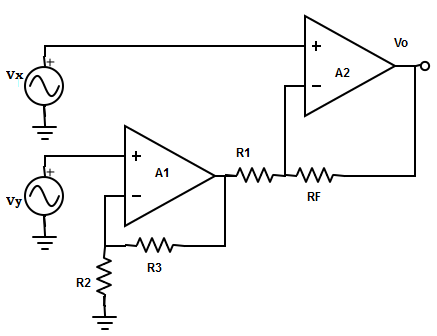
a) RIFx = 83GΩ, RIFy = 317GΩ
b) RIFx = 90GΩ, RIFy = 400GΩ
c) RIFx = 59GΩ, RIFy = 269GΩ
d) RIFx = 36GΩ, RIFy = 156GΩ
View Answer
Explanation: The input resistance of the first stage is given as RIFy,
=> RIFy = Ri*[1+(A *R2)/( R2+ R3)] = RIFy = 2MΩ*[(1+200000*5.7kΩ)/(5.7kΩ+1.5kΩ)] = 3.166*1011 = 317GΩ.
Similarly the input resistance of the second stage amplifier is given as RIFx,
=> RIFx = Ri*[1+(A *R1)/( R1+ RF)] = RIFx = 2MΩ*[(1+200000*1.5kΩ)/(5.7kΩ+1.5kΩ)] = 83GΩ.
4. Determine the output voltage from the diagram. Where V1=-4.3Vpp and V2 = -5.1Vpp sinewave at 1000hz.
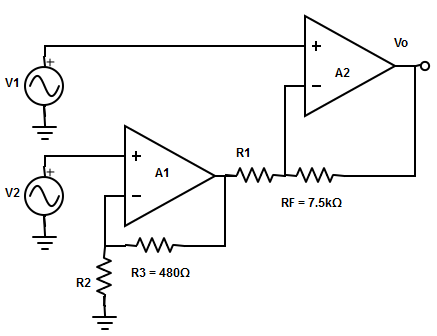
a) 12 Vpp sinewave at 1000hz
b) 13.3 Vpp sinewave at 1000hz
c) 14 Vpp sinewave at 1000hz
d) 11 Vpp sinewave at 1000hz
View Answer
Explanation: In differential amplifier with two op-amp, R1=R3 and RF=R2. The closed loop voltage gain, AD = 1+( RF/ R1) = 1+(7.5kΩ/480Ω) = 16.62.
Output voltage , Vo = AD(V1– V2) = 16.62(-4.3Vpp+5.1Vpp) = 13.29 =13.3 Vpp sinewave at 1000hz.
5. Determine the output resistance of differential amplifier with three op-amp. The op-amp used is 741c, with A=200000 and Ro. The output and difference of input voltages are 44 and 11.
a) 5.5mΩ
b) 3.5mΩ
c) 2.4mΩ
d) 1.5mΩ
View Answer
Explanation: Gain AD = Vo/Vid = 44/11 =4.
The output resistance of differential amplifier is given as ROF=Ro/[1+(A/AD)]= 75/[1+(200000/4)] = 1.5mΩ.
6. Find the input resistance for the given circuit
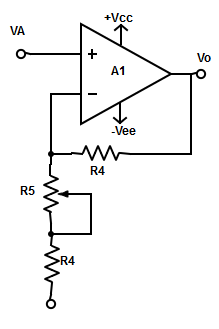
a) RIF = Ri*[1+(A*R4+R5)/(2* R4+R5)].
b) RIF = Ri*[1+(A*R4)/(2* R4+R5)].
c) RIF = Ri*[1+(A*R4+R5)/(R4+R5)].
d) None of the mentioned
View Answer
Explanation: The input resistance of the op-amp with feedback is given as RIF= Ri*(1+AB).
From the diagram, B=Vf/Vo = [R4+R5)/(2* R4+R5)].
Therefore, RIF = Ri*[1+(A*R4+R5)/(2* R4+R5)].
7. The bandwidth of the differential amplifier increases, if the value of
a) Open loop voltage gain decreases
b) Closed loop voltage gain decreases
c) Differential voltage gain decreases
d) All of the mentioned
View Answer
Explanation: The bandwidth of differential amplifier is inversely proportional to the closed loop voltage gain.
8. Calculate the bandwidth for the given circuit.(Where the 741 op-amp has gain of 200000).
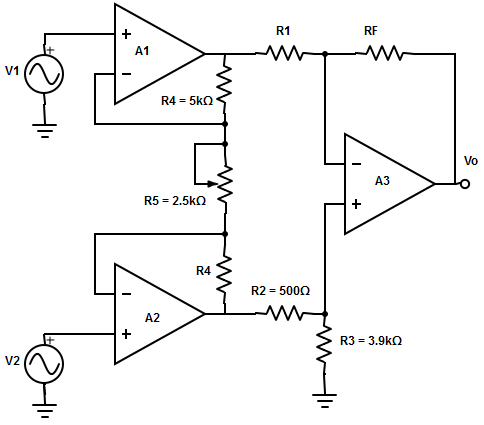
a) 560hz
b) 390khz
c) 25.6khz
d) 1.5Mhz
View Answer
Explanation: Gain of the amplifier AD = -{[1+(2*R4/R5)]*(RF/R1)} = -{[1+(2*5kΩ/2.5kΩ)]*(3.9kΩ/500Ω)} (since, RF = R3 and R2 = R1).
=> AD = -5*7.8=-39.
The bandwidth for the circuit is calculated as fF = (A*fo)/AD = (200000*5hz)/39 (For 741 op-amp 5hz is the break frequency)
=> fF = 25.6khz.
9. Calculate the output voltage. If Vx=3.9Vpp and Vy = 5.5 Vpp sinewave at 1khz for the following circuit.
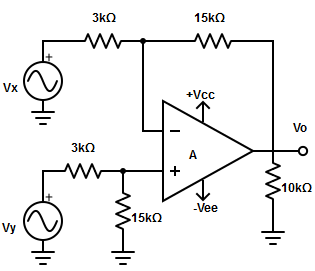
a) 11 Vpp sinewave at 1Khz
b) -8Vpp Vpp sinewave at 1Khz
c) -10 Vpp sinewave at 1Khz
d) 6 Vpp sinewave at 1Khz
View Answer
Explanation: Voltage gain, AD=-RF/ R1 = -15kΩ/3kΩ = -5kΩ.
The output voltage, Vo = – AD*(V x– V y) = 5*(3.9-5.5) = -8 Vpp sinewvae at 1Khz.
Sanfoundry Global Education & Learning Series – Linear Integrated Circuits.
To practice Linear Integrated Circuit Question Bank, here is complete set of 1000+ Multiple Choice Questions and Answers.
If you find a mistake in question / option / answer, kindly take a screenshot and email to [email protected]
